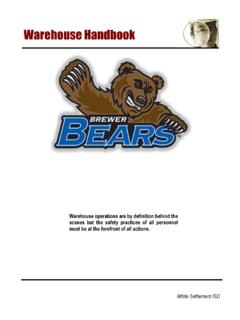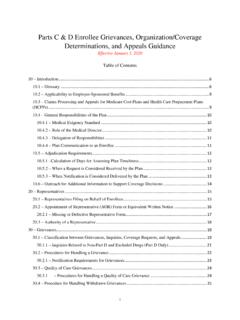Transcription of Instructions to Develop a Dashboard
1 Instructions to Develop a Dashboard Directions: A Dashboard can be helpful as a way to monitor the progress of QAPI in your organization, or the progress of individual projects. The complexity of a Dashboard can vary based on the needs of the organization and whether or not you have an automated system to assist in pulling data into the Dashboard . Your team should use this tool to guide the process of developing a Dashboard . The steps below are intended to help the team members understand the value of a Dashboard and the process for creating a Dashboard . Step 1 Review Dashboard basics: What is a Dashboard ?
2 Like the panel of signals that allow a driver to monitor the functioning of a car, a Dashboard is a system to track key performance indicators within an organization. It is meant to be designed so that it is easy to read and quick to understand, providing signals of where things are going well and where there are problems to address. It should include short term indicators to make sure that milestones are being met, and outcome measures that reflect whether goals are being met. Why is a Dashboard important? Regular monitoring of data is critical for effective decision-making in any organization. At the same time, the amount of data available can be overwhelming and long data reports containing all possible information are not likely to be used and may not be meaningful.
3 A Dashboard is an ideal way to prioritize the most important indicators for a particular organization and encourage regular monitoring of the results. What does a Dashboard look like? Dashboards may be simple text documents, data spreadsheets, or sophisticated graphs developed with computer programs. Data results are reported for multiple time periods to show trends over time and include benchmarks or goals to put performance into context. An organization's main Dashboard ideally fits onto one page, showing only a select set of the most important indicators to monitor. Sub-dashboards may then be created so that users can drill-down to see more detailed data on a specific issue.
4 Dashboards typically employ a system of visual alerts such as red-yellow-green stoplight coloring, speedometers or thermometers that help to draw viewers' attention to data results indicating an area for concern. Step 2 Decide how your Dashboard will be used: What type of Dashboard do we need? Different dashboards may be useful for different audiences. For instance, a Dashboard geared to a board of directors would need to monitor not only the overall quality and specific clinical or organizational quality indicators for the facility but also its financial health. Similarly a top administrator needs to have a high-level view of the performance of the organization, while an individual staffing unit may have a Dashboard that concerns the area of care for which it is specifically responsible.
5 Additionally, you may decide to create a Dashboard that distinctively monitors the success of a particular QAPI activity. Ideally, any sub-dashboards created will be tied to the main organizational Dashboard so that all efforts are working in sync with the overarching vision and goals of the organization. Step 3 Create your Dashboard : Disclaimer: Use of this tool is not mandated by CMS, nor does its completion ensure regulatory compliance. The following is a list of steps to consider in developing a Dashboard . These steps are not necessarily listed in the order in which they must take place, but represent a general path to follow in creating a Dashboard panel for your organization.
6 Determine what type of Dashboard you are creating and its purpose. For example, this may be a main organizational Dashboard for the purpose of monitoring the facility's overall health or a project- centered Dashboard to examine the results of specific improvement efforts. Assemble the team. Depending on which type of Dashboard you are creating, the highest level of leadership taking ultimate responsibility for the indicators will need to be involved. Other key team members include those responsible for producing the results measured, those affected by the results as well as any other users of the Dashboard tool.
7 Gathering input from your quality committee will provide the best vantage point to select the most appropriate indicators as well as help to ensure buy- in and support for the process. Write an objective for what the Dashboard should monitor. For a main organizational Dashboard , this will involve reviewing the organization's mission, vision and strategic plan to elicit the most important goals for the organization to achieve. For a project-level Dashboard , the objective will relate to the outcomes the improvement efforts are trying to produce. A Dashboard in this case can help to emphasize the different parts of the system that influence whether or not the outcome is achieved.
8 Establish the principal measure domains to include. Based on your written objective for what the Dashboard should monitor, determine all of the principal measure domains that must be included in order to adequately meet your measurement objectives. Domains could include clinical outcomes, satisfaction, quality of life, safety, finances, staffing or various other domains (see Inventory of Potential Measures and Indicators). Determine what indicators are available within each of the measure domains you have selected. Indicators can be drawn from your own internal data sources, from the literature regarding appropriate and expected rates of an activity or situation, from state-sponsored report cards or inspections, national campaigns such as Advancing Excellence in America's Nursing Homes or federal initiatives such as CMS' Nursing Home Compare.
9 Select indicators. This step will involve reviewing the list of potential indicators available, gathering input from team members and other stakeholders, and looking for sources that will provide either an evidence-base for setting a specific goal level for the indicator or a benchmark goal based on the performance of other facilities. Set indicator goals. Upon selecting the indicators to include in your Dashboard and reviewing available sources to set goals, establish the preliminary goal level you aim to achieve for each indicator. You may choose to set progressive goals over a particular period of time ( , goal of a 10% reduction in the first year followed by a 20% reduction in the following year.)
10 Disclaimer: Use of this tool is not mandated by CMS, nor does its completion ensure regulatory compliance. Define the specifications for each indicator. Establish how each indicator will be defined and measured by identifying its numerator, denominator, data source, measurement period and any exclusions allowed. This may include a listing of any data codes used in health record management systems. Develop a data collection plan . Establish the frequency at which the indicator will be measured and the person(s) responsible for collecting the data and entering it into the Dashboard . Different indicators may be collected on different time lines and data time periods should be denoted clearly on the Dashboard .












